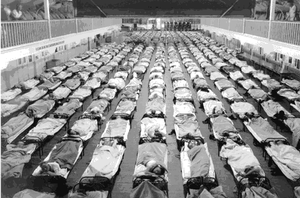Pandemics1918 pandemic flu virus mystery solved
Just as the world was recovering from the devastation of the First World War, another killer swept across the globe. A deadly flu virus attacked more than one-third of the world’s population, and within months had killed more than fifty million people — three times as many as the war — and had done it more quickly than any other illness in recorded history. Until now, the origin of the 1918 pandemic flu virus and its unusual severity have vexed health experts. A new study not only sheds light on the devastating 1918 pandemic, but could also improve vaccination strategies, and pandemic prevention and preparedness.

Rows of patients in makeshift wards were common in 1918 // Source: dartmouth.edu
University of Arizona researcher Michael Worobey and his team have discovered that the key to understanding influenza pandemics may lie in flu exposure during childhood.
Just as the world was recovering from the devastation of the First World War, another killer swept across the globe. A deadly flu virus attacked more than one-third of the world’s population, and within months had killed more than fifty million people — three times as many as the war — and had done it more quickly than any other illness in recorded history.
Until now, the origin of the 1918 pandemic flu virus and its unusual severity have vexed health experts. A UA release reports that a new study, led by Michael Worobey, professor in the University of Arizona Department of Ecology and Evolutionary Biology within of the College of Science, not only sheds light on the devastating 1918 pandemic, but could also improve vaccination strategies, and pandemic prevention and preparedness.
“If our model is correct, then current medical interventions, especially antibiotics and vaccines, against several pneumonia-causing bacteria, could be expected to dramatically reduce mortality, if we were faced today with a similar set of pandemic ingredients,” Worobey said.
“Ever since the great flu pandemic of 1918, it has been a mystery where that virus came from and why it was so severe and, in particular, why it killed young adults in the prime of life,” Worobey added. “It has been a huge question whether there was something special about that situation, and whether we should expect the same thing to happen tomorrow.”
Worobey and his colleagues developed an unprecedentedly accurate “molecular clock” approach to untangle the origins of the 1918 pandemic H1N1 influenza A virus, the classical swine H1N1 influenza virus, and the post-pandemic seasonal H1N1 lineage that circulated from 1918 until 1957. A molecular clock is a technique used in evolutionary biology to reconstruct family trees of organisms — or viruses — based on the number of genetic mutations accumulating over time.
The researchers discovered that the pandemic virus arose shortly before 1918, when a human H1 virus, which they infer had already been circulating in the human population since about 1900, picked up genetic material from a bird flu virus.
